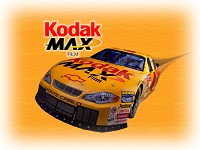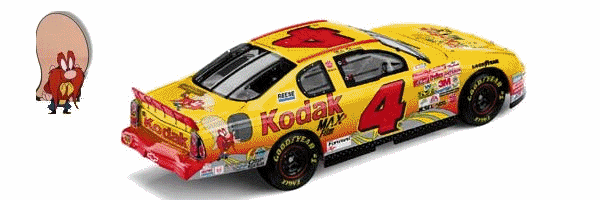| Author |
Comment |
gofour
Unregistered
User
(8/12/02 10:08:00
pm) |
Swaybar
answer
ZNAKOMI,
You asked about the swaybar and the
trackbar.
Lets start with the swaybar. It is called many
things but is correctly called an anti-sway or better yet an
anti-roll bar.
Most everyone has one on the front of their
road car. (Look at it sometime) Some of you have one on the rear as
well. The anti-roll bar is best described as round metal rod with
the ends bent backward. Sort of a U-shaped rod if you will. They
come in all sorts of rod diameters. Usually the larger the vehicle
the larger the diameter of the rod.
In order to understand
the use of the anti-roll bar we must first discuss the mechanics of
the suspension. In the front end of the car the wheels are mounted
to a hub which is bolted to a spindle. The spindle is connected to a
steering knuckle which in turn is connected to two A shaped arms
(called....A arms). There is an upper and lower A arm on each front
wheel. The upper and lower A arms are mounted to the frame in such a
way that they can move up and down. The coil spring we have talked
so much about is located between these A arms. The bottom of the
spring presses against the lower A-arm and the top of the spring
presses against a round plate mounted to a jacking bolt which is
threaded through the frame. (The jacking bolt is what is used to
compress or decompress the spring for wedge adjustments) The
anti-roll bar is bolted to the lower A arm on each side of the car
and supported in rubber mounts attached to the frame.
The
anti-sway bar's job is simple. It's sole purpose is to control the
amount of body roll the car experiences in a turn. As you all know a
cars weight transfers from the inside to the outside of the car in a
turn. On an oval track the left side weight (sprung weight only)
transfers to the right side of the car. Sometimes this is so
excessive that he left side tires come completely off the ground. In
stock car racing it is NEVER a good thing for any tire to come off
the ground. Some may think that changing to stiffer springs and
shocks could be the answer but to do so would be to make the
suspension so stiff that it would not be much of a suspension at
all. Somehow the roll must be controlled while maintaining the
suspensions capability to absorb shock and transfer some weight as
required.
Imagine your holding a long thick metal rod in
your hands and that your grip is so strong that the rod can not
rotate in your grasp. If you rotate the rod forward in your right
hand then the rod will force your left hand to rotate forward as
well.
Now imagine that you are holding a long soft rubber rod
in your hands with the same strong grip as before. If you rotate the
rubber rod forward in your right hand the rubber will twist instead
of forcing your left hand forward. If you continue to twist this rod
with the right hand you will eventually build up enough twisting
force in the rubber rod that it begins to force your left hand
forward as well. This twisting force is called torsion.
The
amount that a anti-roll bar can be twisted is controlled by the
thickness of the rod and the material it is made of. Cars use steel
rods almost exclusively and therefore rod diameter is the deciding
factor. A large diameter rod of 3" for example would have so much
resistance to twist (torsion) that each end of the rod would move in
the same direction as soon as twisting force was applied to either
side.
A small diameter rod of 1/2" would twist a great deal
before the other end began to move.
Now lets apply all this
knowledge. (Remember that the anti-roll bar is u shaped and
connected to the lower A-arms which the spring rests on.)
In
order for a cars weight to roll from one side to the other the
following must happen: The spring on the side giving up weight must
expand (decompress) and the spring gaining weight must compress.
Again, remember for a spring to expand (decompress) the lower A-arm
must move downward. Conversely for a spring to compress the lower
A-arm must move upward.
Here is where the anti-roll bar
comes in. When the weight of the car tries to roll over to the right
side and force the RIGHT side lower A-arm upward (putting the rod in
torsion) the rod in turn tries to force the LEFT side lower A-arm
upward. This does not allow the spring on the left to expand as much
as it needs to in order to transfer all the weight to the right. A
solid 3' bar would not allow any expansion of the left a-arm and
therefore no weight would transfer (No body roll). A smaller 1/2"
bar would twist a great deal before forcing the opposite A-arm
upward and therefore more weight would transfer (Much body roll).
Not all body roll is bad. A certain amount is required in
order for the suspension to work. Therefore bar diameters are
usually selected between the sizes I used for examples depending on
how much or how little weight transfer is desired.
The same
effect is true in the rear of the car. (There are no A-arms in the
rear so the bar is effectively mounted to the axle housing). The
same concept applies here - for one side to expand the axle must
move downward and for one side to compress the axle must move
upward. The anti-roll bar works to control the amount of these
movements and therefore controls rear body roll.
Overall, it
can best be understood that the less the body rolls the less the
inside tires are "pulled from the track". And therefore the car
maintains more rubber on the track. Less body roll equals a tighter
car. More body roll equals a looser car. The crewchief sees it this
way: a bigger bar tightens the car and a smaller bar loosens the
car. (Watch the races - sometimes the cars get so extermely tight
the crew chief unhooks the rear bar completely during the race.
Rarely is the front bar unhooked. This is due to the dynamics of the
cars "Roll Center" which is a topic for another time).
Roll
bars between 7/8" and 1 1/2" diameter are the most common sizes used
on the racecar. The team that gets the bar right will find it much
easier to tune the spring package on race weekend.
I'll
answer the track bar question in a separate thread another
time.
Later,
Gofour
|
4the4

Registered
User
Posts: 548
(8/12/02 10:58:49
pm)

|
Re: Swaybar
answer
Thanks gofour, I enjoyed reading that.
4the4 |
ZNAKOMI
Administrator
Posts: 1574
(8/13/02 8:00:14 am)
 |
Re: Swaybar
answer
He's pretty good at explaining this stuff 4te4, ain't
he!
Thanks gofour. Lol, I remember a '66 olds I had where the
rubber bushings were shot on the front antisway bar, and it made the
bushing washers jingle like a sleigh...I replaced the bushings to
stop the noise, but remember laying under there looking at the
bars...finally concluding: "That thing don't do anything"! Ahhh,
youth!
I gotta take a look at a rear end setup to see how
this thing is mounted. The tortion must come from the curve at the
ends (otherwise it would just ride up and down with the lower
A-frames on the front, or housing on the rear)...so i don't have a
good picture of the rear yet..where it is suppoted along the
straight part. If I've got this right, the ends have to be on the
axel housing that moves (relative to the body), but it's support on
the straight length must be supported somewhere on the body?
Lol,
actually I didn't know one was back there at all!
When you
watch a car on tv, and watch it's front air dam as it rolls over,
the antisway bar is used to set it's travel primarily rather than
the springs? That must make it a lot easier...I thought the spring
selection set this primarily.
Thanks a million gofour, nice
contributions to the board!
(can't wait to hear about the
track bar.)
Edited by: ZNAKOMI
at: 8/13/02 8:23:55 am
|
gofour
Unregistered
User
(8/13/02 7:09:39 pm) |
Your
right
ZNAKOMI,
Your right, your right, your absolutely right! The
torsion effect comes from the lever effect of the "arms" of the u
shaped bar. The bar is supported along the straight "middle" portion
by frame hangers to force the bar to twist rather than simply move
up and down.
| |

